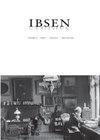The Fusion of the Man and His Work: John Gabriel Borkman with Ibsen's Mask
IF 0.1
0 THEATER
引用次数: 1
Abstract
Henrik Ibsen is, without a doubt, an icon in the modern, secular sense of the term. One effect of his iconic standing is a recent trend within the tradition of Ibsen in performance. Ibsen is no longer just a playwright. An Ibsen production is not necessarily a staging of a play written by him. It may as well be a staging of a play written – or “pieced together” – by someone else, the plot of which is based on events in Ibsen’s life or the design of which is based on Ibsen’s works. Understandably, Ibsen may in these productions occasionally appear as a dramatic figure, as himself. In the past three decades, this trend has increased in volume, with a preliminary peak in the Ibsen Year 2006. The phenomenon is not at all restricted to Norway. Since 2006, productions like this have been traced in Norway, Mexico, USA, Italy, Argentina, Germany, England, Bangladesh, Japan, Canada, Spain, Sweden and China. The Ibsen character in these productions, if there is one, fulfils a number of dramaturgical functions. He may be portrayed in the form of a doll, a statue, a mute, an actor or an actress with lines of dialogue, of young or old age, thick or thin, tall or small. However, despite the diversity in the physical shaping of the Ibsen character, theatre audiences all over the world recognize the character as Ibsen within a fraction of a second when he enters the stage because of the activation of a set of simple, iconographic elements: whiskers, top hat, overcoat, glasses. When did Ibsen turn into an icon? In his latest book, Ibsen og fotografene, Peter Larsen investigates the phenomenon on the basis of photographs of Ibsen. Scrutinizing all extant portrait Ibsen Studies, 2014 Vol. 14, No. 1, 52–70, http://dx.doi.org/10.1080/15021866.2014.937152人与作品的融合:约翰·加布里埃尔·博克曼与易卜生的面具
毫无疑问,亨里克·易卜生是现代世俗意义上的偶像。他的标志性地位的一个影响是在易卜生传统的表演中最近的趋势。易卜生不再仅仅是一个剧作家。易卜生的作品不一定是他写的剧本的舞台。它也可能是另一个人写的或“拼凑”的戏剧的舞台,情节是基于易卜生生活中的事件,或者是基于易卜生作品的设计。可以理解的是,易卜生可能在这些作品中偶尔作为一个戏剧性的人物出现,作为他自己。在过去的三十年里,这一趋势在数量上有所增加,并在2006年易卜生年达到了初步高峰。这种现象并不局限于挪威。自2006年以来,这样的产品已经在挪威、墨西哥、美国、意大利、阿根廷、德国、英国、孟加拉国、日本、加拿大、西班牙、瑞典和中国被追踪到。易卜生在这些作品中的角色,如果有的话,完成了许多戏剧功能。他可能被描绘成一个娃娃,一个雕像,一个哑巴,一个演员或一个女演员的对话,年轻或年老,厚或瘦,高或小的形式。然而,尽管易卜生这个角色的身体形状多种多样,但当他进入舞台时,全世界的戏剧观众在一瞬间就认出了这个角色是易卜生,因为他激活了一系列简单的形象元素:胡须、大礼帽、大衣、眼镜。易卜生是什么时候成为偶像的?在他的新书《易卜生的摄影》中,彼得·拉森以易卜生的照片为基础研究了这一现象。《易卜生研究》,2014年第14卷第1期,52-70页,http://dx.doi.org/10.1080/15021866.2014.937152
本文章由计算机程序翻译,如有差异,请以英文原文为准。
求助全文
约1分钟内获得全文
求助全文

 求助内容:
求助内容: 应助结果提醒方式:
应助结果提醒方式:


